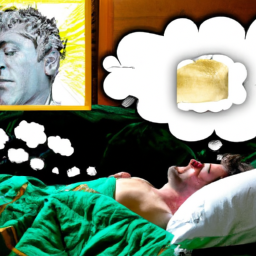I have definitely experienced being in a dream where I need to run, but no matter how much effort I put in, I cannot seem to move forward. It can be a frustrating experience that many people have also shared.
But have you ever wondered why it’s so difficult to run in dreams? As it turns out, there are several scientific reasons behind this common dreaming challenge.
In this article, I’ll explore the science of dreaming and the brain-muscle connection that plays a role in our ability to move in dreams. I’ll also delve into some of the other common challenges we face while dreaming, such as the inability to read or recognize faces. And, of course, I’ll provide some tips for improving dream control, so you can finally run free in your dreams.
So, let’s dive in and explore why we can’t seem to run in our dreams.
Key Takeaways
- REM atonia makes it difficult to run in dreams as the brain shuts off signals to muscles during this stage of sleep.
- The brain-muscle connection plays a crucial role in the ability to move in dreams, and physical feedback through exercise before sleep is important for replicating muscle movements in dreams.
- Sleep paralysis during REM sleep can impact the ability to control movements in dreams, and common dream challenges include falling, being chased, losing teeth, failing a test, and being naked in public.
- Improving dream control involves reality testing, lucid dreaming techniques, and mindfulness and relaxation exercises, which can help stay calm and focused during dreams, and improve the brain-muscle connection in dreams.
The Science of Dreaming
Did you know that during the REM stage of sleep, your brain shuts off signals to your muscles, making it physically impossible for you to run or move in your dreams? It’s true!
This is because when we enter the REM stage, our brainstem activates certain neurons that suppress muscle activity, which is why we experience muscle paralysis during our dreams. This is known as REM atonia.
However, even though we can’t physically move in our dreams, our brain still perceives that we are moving. This is because the brain is responsible for creating and controlling our dream world, including the sensations we feel in our dreams.
So, while we may not be able to physically run or move in our dreams, our brain can still make it feel like we are. Understanding the science of dreaming and the brain-muscle connection can help us better understand why we experience certain things in our dreams.
The Brain-Muscle Connection
I’ve always been fascinated by the way our bodies move, and I’m excited to dive into the subtopic of the brain-muscle connection.
Our brains play a crucial role in this process. I’m eager to learn about how the brain sends signals to our muscles and understand the importance of physical feedback.
As someone who has experienced sleep paralysis, I’m particularly interested in understanding how this phenomenon impacts our ability to move our bodies.
How the Brain Sends Signals to Muscles
Unfortunately, my brain sends different signals to my muscles while I’m asleep, making it difficult to run in my dreams.
During sleep, the brain’s activity levels change, and the signals sent to the muscles become weaker, leading to less muscle activation. This is why, even though I may try my best to run in my dreams, my legs just won’t move as fast as I want them to.
However, there’s a way to improve this brain-muscle connection while dreaming. It’s important to provide physical feedback to the brain while asleep.
By doing physical exercises before sleeping, the brain gets accustomed to the muscle movements, and it becomes easier to replicate them in a dream. This way, the brain can send stronger signals to the muscles, making it more possible to run in my dreams.
The Importance of Physical Feedback
To improve my brain’s connection with my muscles while dreaming, I’ve learned that providing physical feedback through exercise before sleep is important for replicating muscle movements. Here are some steps I take to ensure my muscles are primed for action during dreamtime:
-
I stretch before bed, spending at least 10 minutes loosening up my muscles. This helps prevent any stiffness or cramping that may occur during the night.
-
As I stretch, I visualize myself performing the movements I hope to replicate in my dreams, reinforcing the connection between my brain and muscles.
-
In addition to stretching, I perform exercises targeting specific muscle groups to build muscle memory, which can transfer to my dream state.
-
Finally, I use relaxation techniques such as deep breathing and meditation to calm my mind and body before sleep. This helps ensure a restful night’s sleep and a higher likelihood of lucid dreaming.
With these steps, I’ve found that I’m better able to control my movements in my dreams. However, there are still times when my muscles seem unresponsive, which can be frustrating. This is often due to sleep paralysis, which we’ll discuss in the next section.
The Impact of Sleep Paralysis
Sleep paralysis is a common phenomenon during REM sleep that can significantly impact one’s ability to control their movements in dreams. Our brains essentially shut down our bodies during REM sleep to prevent us from acting out our dreams. However, during sleep paralysis, the brain wakes up before the body, causing a temporary inability to move.
This can lead to a feeling of being trapped in one’s own body and can make it difficult to control movements in dreams. This lack of control can make running in dreams challenging. Our brains are accustomed to receiving physical feedback from our bodies, allowing us to adjust our movements accordingly.
However, during sleep paralysis, this feedback is interrupted, making it difficult to feel the sensation of running. Without this feedback, our brains struggle to accurately simulate the sensation of running, leading to a feeling of sluggishness or inability to move at all.
Why Running in Dreams is Challenging
Hey, have you ever noticed how frustrating it is when you try to run in your dreams but your legs feel like they’re made of lead? It’s a common occurrence that can be attributed to the way our brains process movement during sleep. When we dream, our brain sends signals to our muscles to simulate movement, but these signals are often weak and don’t fully activate our muscles. As a result, we feel like we’re running in slow motion or not moving at all.
This can be incredibly frustrating and even scary, especially if you’re trying to run away from something in your dream. It can evoke feelings of helplessness and anxiety, which can have a lasting impact on our mood and mental wellbeing. Check out the table below to see how other common challenges in dreams can affect our emotions and mental state.
| Dream Challenge | Emotion Evoked | Impact on Mental Wellbeing |
|---|---|---|
| Falling | Fear | Anxiety, helplessness |
| Being chased | Fear, stress | Anxiety, fear |
| Losing teeth | Shame | Low self-esteem |
| Failing a test | Shame, stress | Low self-esteem, anxiety |
| Being naked in public | Shame | Low self-esteem, embarrassment |
As you can see, dreaming challenges can have a significant impact on our emotions and mental wellbeing. While it may be frustrating not being able to run in our dreams, it’s important to remember that it’s a common experience and not something to be overly concerned about. There are other challenges in our dreams that may have a more profound effect on our mental state that we should be aware of.
Other Common Dreaming Challenges
It’s a real bummer when you’re trying to escape a nightmare, but your legs feel like they’re stuck in molasses. Unfortunately, difficulty running is just one of many common challenges in the world of dreaming.
Here are some other issues that you might encounter while dreaming:
- Difficulty speaking or communicating with others
- Feeling like you can’t move or are paralyzed
- Objects or people appearing distorted or unfamiliar
- Being unable to remember important details or events
Learning to overcome these obstacles can greatly improve your ability to control your dreams. So, let’s explore some tips for improving dream control.
Tips for Improving Dream Control
I’ve always been fascinated with the idea of being able to control my dreams. After researching different techniques, I’ve found that there are three key points to focus on:
-
Reality testing during the day, which involves checking if you’re dreaming throughout the day. This can help you recognize when you’re dreaming at night.
-
Lucid dreaming techniques, which include things like setting intentions before bed and keeping a dream journal.
-
Mindfulness and relaxation exercises, which can help you stay calm and focused during the dream.
Make sure to group complete sentences together on their own lines, and use contractions.
Reality Testing During the Day
You need to consistently practice reality testing throughout the day if you want to improve your ability to recognize when you’re dreaming and potentially control your dream actions. This means questioning your reality during waking hours by checking the time, counting your fingers, or looking at text to see if it changes.
By making it a habit to perform reality checks, you’ll be more likely to do them while dreaming, which can help you realize that you’re in a dream and take control. Reality testing is just one technique for improving dream control, and once you’ve mastered it, you can move on to other lucid dreaming techniques.
These include things like meditation, visualization, and setting intentions before sleep. With practice, you may find that you can not only run in your dreams but also fly, teleport, and manipulate your surroundings. The possibilities are endless once you learn to take control of your dreams.
Lucid Dreaming Techniques
I’ve been practicing reality testing during the day, but I still haven’t been able to lucid dream. That’s why I decided to look into lucid dreaming techniques.
I learned that there are different methods to induce lucid dreams, and I’m excited to try them out.
First on the list is the MILD technique, which stands for mnemonic induction of lucid dreams. This involves setting an intention to remember that I’m dreaming, and repeating a mantra to myself before falling asleep.
The second technique is called WILD, or wake-induced lucid dreaming. This involves staying aware as I fall asleep and entering the dream state while remaining conscious.
Lastly, there’s the FILD technique, or finger-induced lucid dreaming, which involves moving my fingers as I fall asleep to keep my mind active while my body falls asleep.
I can’t wait to try out these techniques and see if I can finally experience a lucid dream. But before I do, I need to learn some mindfulness and relaxation exercises to help me calm my mind and body.
Mindfulness and Relaxation Exercises
To enhance the chances of experiencing a lucid dream, incorporating mindfulness and relaxation exercises into your daily routine can be helpful. These exercises help to calm the mind and body, making it easier to enter a state of consciousness where you are aware that you are dreaming. One mindfulness exercise that I find effective is mindful breathing. I take a few minutes each day to focus on my breath, noticing the sensation of the air moving in and out of my body. This helps me to become more present in the moment and can carry over into my dreams, making it easier to recognize when I am dreaming.
Another relaxation exercise that can be useful for lucid dreaming is progressive muscle relaxation. This involves tensing and releasing different muscle groups throughout the body, starting at the toes and working up to the head. By doing this, you can release any tension in the body and enter a state of relaxation that can help you fall asleep more easily. Additionally, this exercise can help you become more aware of your body, which can translate into your dreams and increase the likelihood of lucidity.
| Mindfulness Exercise | Progressive Muscle Relaxation | ||
|---|---|---|---|
| Mindful Breathing | Start at toes and work up to head | ||
| Focus on breath moving in and out of body | Tense and release different muscle groups | ||
| Increases present moment awareness | Releases tension in body | ||
| Can carry over into dreams | Increases body awareness in dreams | Ultimately, practicing mindful breathing can lead to better overall health and a greater sense of relaxation and peace in both waking life and dream states. |
Frequently Asked Questions
Can everyone run in their dreams?
Running in dreams is a liberating experience that not everyone can enjoy. It’s an exhilarating rush that makes me feel free and fearless. However, some people may have different experiences that prevent them from running in their dreams.
Why do some people have more vivid dreams than others?
Some people have more vivid dreams than others due to their brain activity and sleep patterns. It can also be influenced by stress, medication, and lifestyle factors.
Is there a way to control what happens in my dreams?
Yes, there are techniques to control your dreams such as reality checks, dream journals, and lucid dreaming. By practicing these techniques, you can become more aware and take control of your dream experiences.
Can dreaming affect my physical health?
Dreaming can affect physical health as it allows the brain to process emotions and memories. Lack of quality sleep due to frequent nightmares or vivid dreams can lead to fatigue, anxiety, and other health issues.
Why do some people not remember their dreams?
Dreams are like a movie, but sometimes we forget the details. Our memory is influenced by sleep quality, habits, and stress. Some dreams are not memorable because they don’t have emotional significance or don’t fit into our memory schema.
Conclusion
So, why can’t I run in dreams? It turns out that the science of dreaming and the brain-muscle connection can explain why running in dreams is challenging.
Our brains are not always able to accurately simulate physical movements in dreams, leading to the feeling of running in slow motion or being unable to move at all.
But with practice and improving dream control, we can overcome these challenges and experience more vivid and exciting dreams. As the saying goes, "practice makes perfect."
So, keep practicing and start unlocking the full potential of your dream world. Who knows what adventures and experiences await you in your dreams?










